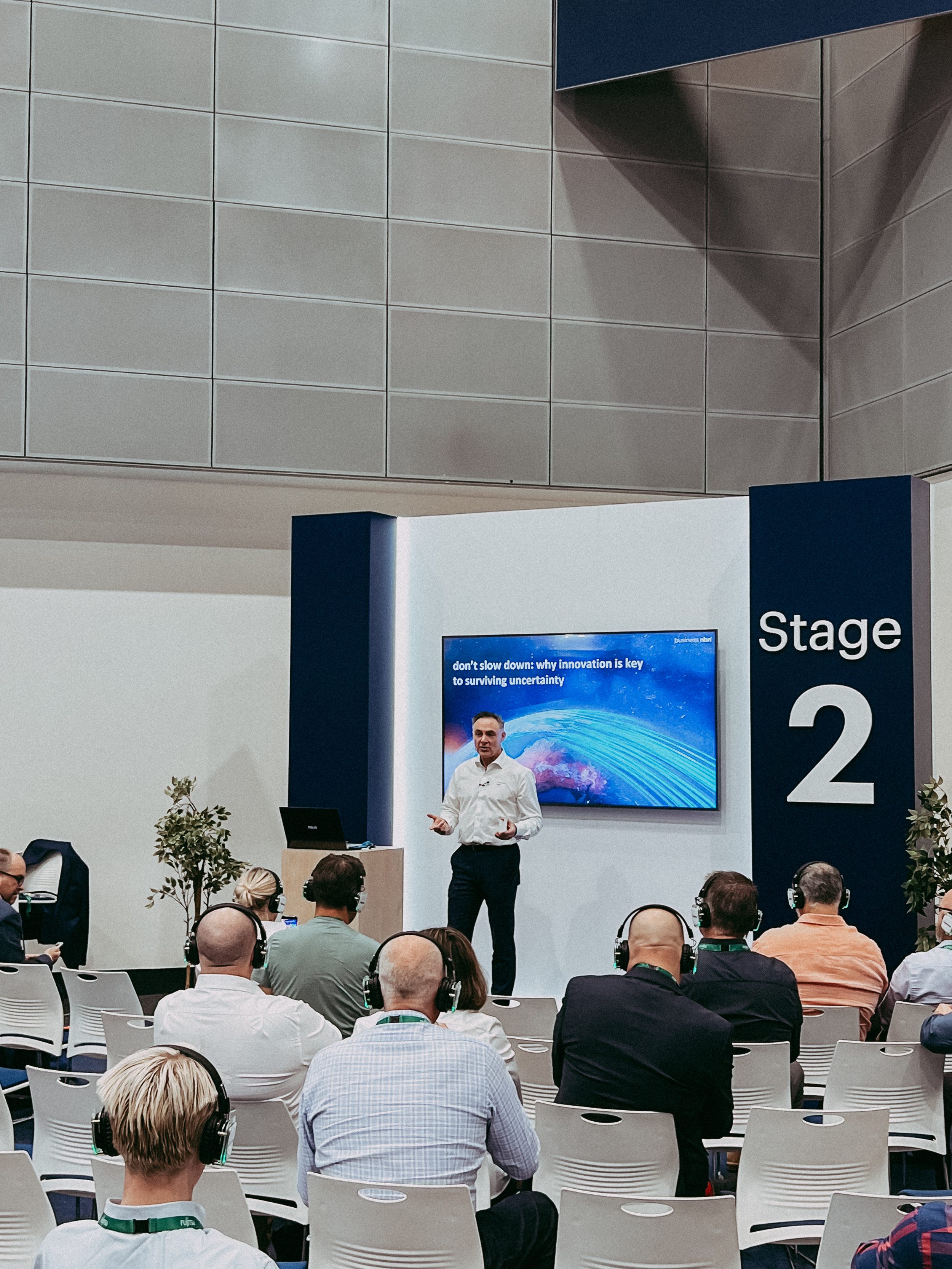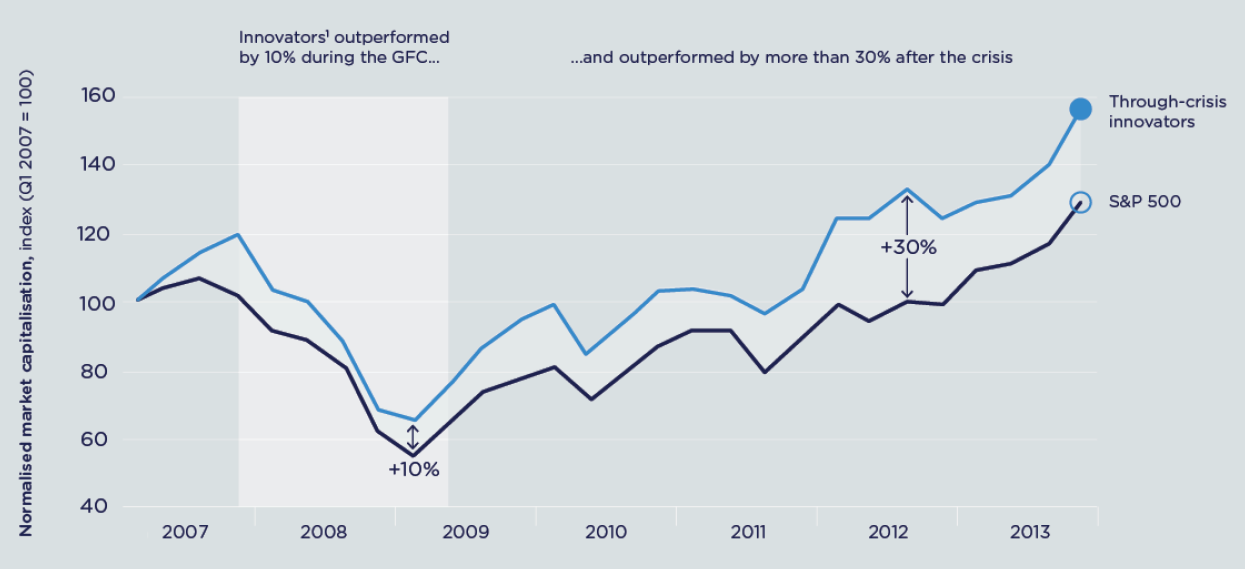This article is based on the address ‘Don’t slow down: why innovation is key to surviving uncertainty’ given by Brendan Donohoe, nbn’s Executive General Manager of Business, at the Gartner IT Symposium/Xpo in September 2022.
During uncertain times, innovation and transformation give businesses a way to survive and get back to growth.
While restrictions imposed to help stop the spread of the COVID-19 pandemic are easing, businesses are still experiencing the aftereffects. Employing staff is a struggle, travel isn’t as easy as it used to be, and uncertainty around supply chains remains.
Global politics, an unclear economic outlook and the severe weather events we’ve seen this year have added to the uncertainty. Yet, if we’ve learnt anything from the pandemic, it’s that uncertainty is the new certainty. Whatever our old normal was, we won’t be going back to it. We can only move forward.

The innovation imperative
When things are uncertain, it’s tempting to hit pause, wait and see what happens, then move when the situation becomes clearer.
I’d argue that’s a mistake. Is there really a reason not to do something? For one thing, the big, clear signal that you are waiting for might not come – or you may never recognise the signal.
If we are going to build a strong, robust, digital economy, now is not the time to slow down. In fact, the opposite is true. In times of uncertainty, innovation, transformation and even acceleration are critical.
Why? With innovation and transformation comes the opportunity to get ready for change and to reshape our businesses, no matter how big they are or where they are located.
Modern technology infrastructure makes this so much easier and cheaper to do. And we don’t have to wait for a crisis to act. Why did it take a global pandemic for us to see how video conferencing – which we’ve had for years – unlocks hybrid and remote working? We need to be future-ready, now.
History lesson
Apple is a great example that shows why it’s important to keep innovating. The company helped establish the personal computer market back in the 1980s, but then lost its way. By the mid-90’s Apple was on the verge of bankruptcy. Then Steve Jobs came back and innovation returned in the form of the original iMac. It was a smash hit, selling millions of units, and is credited with saving the company1.
When its future was far from clear, Apple turned to innovation as its way forward and its success sky-rocketed.
Then in 2007, just as the Global Financial Crisis was emerging, Apple released its game-changing iPhone. As its rivals stumbled, Apple powered through the recession2, putting itself on a path to becoming one of the world’s most valuable companies.
For the world’s most dynamic companies, innovation and transformation aren’t just luxuries to be pursued during the good times - they are also how you ride out the storms.
Australia’s COVID experience
With COVID, we had another chance to see how transformation and innovation can carry companies through uncertainty. We’ve all heard the stories of Australian businesses who’ve pivoted and transformed, changing their products, embracing change and thriving in a largely digital economy.
At nbn we’ve featured some great case studies of Australian companies that have had to do just that. Pirate TV, for example, was a live-events company that had to pivot and recreate their business3 to deal with the restrictions imposed as a result of COVID. The two owners, Simon and Mykel, now have a business that has been very successful in running digital events from their base on the Mornington Peninsula in Victoria.
Research commissioned by nbn5 at the end of 2020 showed that among small businesses, 84% of those that already had a digital transformation strategy were able to fast-track the implementation in response to the pandemic. Additionally, more than half were able to accelerate it by more than six months.
In contrast, companies that didn’t have strategies in place sometimes had to cobble together solutions just to get by, in ways that didn’t necessarily support their broader goals and strategies.
The post-crisis acceleration advantage
Companies that invested in innovation during the GFC outperformed peers during the recovery

Source: Innovation in a crisis: Why it is more critical than ever, McKinsey & Company, 2020
Research from McKinsey6 suggests that companies that continued to innovate through the GFC outperformed the US’ S&P 500 index by 10% during the crisis. That advantage continued to multiply, and five years later they were outperforming the market by 30%.
That was more than a decade ago. Today, given the scale and speed the digital economy now operates at, allowing a competitor the opportunity to become a leader in innovation is even more dangerous.
It can take courage, and you may have to convince a few doubters – maybe even yourself - but there is plenty of evidence to show that we can’t let innovation go off the boil.
Having an innovation mindset
But why does nbn care about innovation? Put simply, our purpose is to lift the digital capability of Australia. We're a critical enabler. As Australia’s digital backbone, we know just how important the nbn network is for keeping our nation connected and productive. Today, high-speed internet access is critical in underpinning the digital strategies that enable transformation, innovation and acceleration.
But even before you get to that digital strategy, you need an innovation mindset. And you need a culture of innovation to support and grow that mindset. Building that culture requires leadership. KPMG estimates that when it comes to innovation, 70 per cent of the impact to culture comes from leadership decisions7.
What do leaders need to do? According to KPMG, they need to clearly communicate goals and expectations, build the capacity to deliver and be creative, and crucially - be prepared to embrace failure as a necessary part of the innovation process.
Then, once they’ve got their culture up and running, businesses need to set to work on building innovative solutions.
Then they can acquire, partner, or invest in the new technology that’s going to make it happen - and that’s where business nbn wholesale products and services can play a role.
Available from a range of providers, businesses can choose from a variety of business nbn powered plans, over three different technology solutions: dedicated business-grade fibre from the fibre access node to the business premises; shared fibre to the premises, node, curb, basement, or hybrid fibre coaxial, and business satellite services§.
Plus, we have created 321 business nbn fibre zones across the country to date, with more than a third of those in regional areas. In these areas we offer discounts to our service provider partners to help make business-grade fibre access more affordable.
At business nbn we are seeing a surprising number of small and medium business (SMB) end customers opt for high-bandwidth services on fibre connections, and reaping the rewards.# Meanwhile enterprise and government end customers are sometimes selecting lower bandwidth services than their SMB peers.
But if you could imagine having more bandwidth, what would you do differently? What applications would you run? How would you manage your team differently? How would you interact with customers differently? I'd encourage you to start thinking along those lines.

Continuous evolution
Whatever your business has planned, we want to support you to transform and innovate.
And we know, like everyone else, we have to evolve too. And since the completion of the initial volume build phase of the nbn network, that’s what we have been doing.^
We’ve expanded the business nbn fibre zones to 11.2 million premises across the country which can now access plans based on our flagship business nbn Enterprise Ethernet† wholesale service. Recently we’ve announced our range of wholesale speed tier options for Enterprise Ethernet have increased, which is now available through our service provider partners with wholesale speed tier options ranging close to 10Gbps symmetrical‡# .
Technology has never been more accessible and customer experiences have changed to become digital-first. The gap between leading and lagging in the digital field is growing and you don’t want to be on the wrong side of the ledger.
Maintaining innovation gives an organisation a much better chance of riding out whatever bumps come along, and, crucially, leaves it far better positioned to grow when the good times eventually return.
Times may still be uncertain, but history tells us that now is not the time to slow down. It’s actually a good time to accelerate your digital transformation.
What is Enterprise Ethernet?
Sources
- How Apple went from bust to five million colourful iMacs sold, Apple Insider, April 2020
- Apple sets revenue record during recession, Computerworld, January 2009
- Sailing the employee engagement seas with Pirate TV, NBN Co, July 2022
- Australian Broadband Data Demand: upload demand on the rise as more Australians work from home and spend Easter at home, NBN Co, April 2020
- Telsyte Australian Digital Workplace Study 2021
- Innovation in a crisis: Why it is more critical than ever, McKinsey & Company, 2020
- Building an innovation culture, KPMG, June 2022
† business nbn Enterprise Ethernet is only available in the nbn Fixed Line network footprint and at limited premises served by the nbn Fixed Wireless and Satellite networks.
‡ Regardless of the bandwidth profile for the service you acquire from your service provider, it may operate at less than 10,000 Mbps (or, in some circumstances, 1,000 Mbps, if that bandwidth profile is acquired) because of normal equipment and network limitations.
# nbn provides wholesale services to phone and internet providers. nbn wholesale speed tiers available to providers vary depending on the access technology in your area. Your experience, including the speeds actually achieved over the nbn network, depends on the nbn access technology and configuration over which services are delivered to your premises, whether you are using the internet during the busy period, and some factors outside of nbn’s control (like your equipment quality, software, chosen broadband plan, signal reception, or how your provider designs its network). Speeds may also be impacted by the number of concurrent users on the nbn Fixed Wireless network, including during busy periods. Satellite end customers may also experience latency. For business nbn Enterprise Ethernet, if your service provider has not selected a bandwidth in the highest of three classes of service available for business nbn Enterprise Ethernet, the speeds you experience may be affected by contention on the nbn network, particularly in busy periods.
^ Please note that network construction will be an ongoing activity beyond the initial volume build for future new developments and a small proportion of premises defined as ‘complex connections’ – which includes properties that are difficult to access, culturally significant areas and heritage sites – where connection depends on factors outside of nbn’s control such as permission from traditional owners.
§ nbn is withdrawing the business nbn® satellite service on 31 December 2025.
